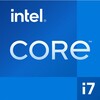Qualcomm Snapdragon X Elite X1E-80-100 vs Intel Core i7-1260U vs Qualcomm Snapdragon X Plus X1P-64-100
Qualcomm Snapdragon X Elite X1E-80-100
► remove from comparison
The Snapdragon X Elite X1E-80-100 is a pretty fast ARM architecture processor (SoC) for use in Windows laptops. The X1E-80-100 is the second-fastest member of the Snapdragon X series, as of May 2024; as such, it has 12 Oryon CPU cores (3 clusters of equally powerful cores; 12 threads) running at up to 4.0 GHz, the 3.8 TFLOPS Adreno X1-85 GPU, the 45 TOPS Hexagon NPU and an impressively fast LPDDR5x-8448 memory controller.
The faster Snapdragon X Elite X1E-84-100 is thought to be based on the same die with the same NPU and the same number of CPU cores but with higher GPU and CPU clock speeds.
Architecture and Features
Qualcomm Oryon cores are in part based on Nuvia IP; they most likely make use of the ARM v8.7 microarchitecture. Much like modern AMD and Intel processors, the Snapdragon chip is compatible with USB 4 and thus with Thunderbolt 4 but it remains to be seen if it is is compatible with GeForce or Radeon discrete graphics cards.
The Qualcomm SoC is thought to have at least 12 PCIe 4 and 4 PCIe 3 lanes for connecting various kinds of devices. NVMe SSDs are supported with a throughput of up to 7.9 GB/s; furthermore, most laptops built around the chip are expected to have 16 GB of LPDDR5X-8448 RAM. There is also a 45 TOPS NPU for accelerating AI workloads.
Performance
When all of the 12 cores are under load, they can run at up to 3.4 GHz. The much more desirable 4.0 GHz clock speed is only achievable under single-thread or dual-thread loads.
Given the very similar clock speeds, its multi-thread benchmark scores should be about the same as that of the X1E-78-100 for Ryzen 7 7840U and Apple M3-like performance in most real-world tasks. We'll make sure to update this section once we get our hands on a system powered by the X1E-80-100.
Like any other Windows on ARM platform, the Snapdragon X chip works best with applications and games compiled specifically for ARM processors. If making use of the built-in x86 to ARM emulation mode, a performance penalty of about 20% is to be expected.
Graphics
The integrated 3.8 TFLOPS Adreno X1-85 GPU is DirectX 12-enabled but not DirectX 12 Ultimate-enabled, despite featuring VRS and ray tracing support. The 3.8 TFLOPS of performance that it delivers pale in comparison to the slowest current-generation professional Nvidia Ada graphics card for laptops, the RTX 500 Ada, that delivers up to 9.2 TFLOPS.
Its gaming performance is somewhat underwhelming. While slightly faster than the aging Iris Xe (96 EUs), the Adreno is not fast enough to outpace the Radeon 780M meaning there is little point in comparing it with full-fat discrete graphics cards. Baldur's Gate 3, a triple-A title released in 2023, is pretty much unplayable at 1080p / Low. GTA V, a game that saw the light of day in 2015, is playable at 1080p / High.
The Qualcomm iGPU will let you use up to 3 UHD 2160p monitors simultaneously. 2160p120 integrated displays are supported, as are the popular AV1, HEVC and AVC video codecs (both decoding and encoding). The hardware does not support the VVC codec; that feature remains a Lunar Lake exclusive for now.
Power consumption
The X1E-80-100 is most likely going to be less power-hungry than its more powerful brother (the latter can be set to consume up to 80 Watts). Expect to see anything between 20 W and 45 W under long-term workloads because that's what Ryzen HS chips normally consume.
The SoC is built with a 4 nm TSMC process for decent, as of H1 2024, energy efficiency.
Intel Core i7-1260U
► remove from comparison
The Intel Core i7-1260U is a mobile CPU for thin and light laptops based on the Alder Lake architecture. It was announced in early 2022 and offers 2 performance cores (P-cores, Golden Cove architecture) and 8 efficient cores (E-cores, Gracemont architecture). The P-cores support Hyper-Threading leading to 12 supported threads when combined with the E-cores. The clock rate ranges from 1.1 to 4.7 GHz on the performance cluster and 0.8 to 3.5 GHz on the efficient cluster. The performance of the E-cores should be similar to old Skylake cores (compare to the Core i7-6700HQ). All cores can use up to 12 MB L3 cache. The 1260U offers "Enterprise" vPro management features. Compared to the P-series (28W) or H-series (45W), or even the 15W U-series, the 9W TDP will limit the sustained performance.
Performance
Compared to the old 7 Watt Comet Lake-Y series (like the i7-10510Y), the performance should be clearly better thanks to the 10 cores and the improved architecture of the P-cores. Compared to the 15 W U-series (like the similar specified Core i7-1265U) the sustained performance will be clearly limited by the 9 Watt TDP. As always, the performance will also greatly depend on the cooling solution, especially for fanless laptops and tablets.
Features
The integrated memory controller supports various memory types up to DDR5-4800, DDR4-3200, LPDDR5-5200, and LPDDR4x-4267. The Thread Director (in hardware) can support the operating system to decide which thread to use on the performance or efficient cores for the best performance. For AI tasks, the CPU also integrates GNA 3.0 and DL Boost (via AVX2). Quick Sync in version 8 is the same as in the Rocket Lake CPUs and supports MPEG-2, AVC, VC-1 decode, JPEG, VP8 decode, VP9, HEVC, and AV1 decode in hardware. The CPU only supports PCIe 4.0 (x8 for a GPU and two x4 for SSDs).
The integrated graphics card is based on the Xe-architecture and offers all 96 EUs (Execution Units) operating at up to 0.95 GHz.
Power consumption
This 12th gen Core i7 processor has a Base power consumption of 9 W, with 29 W being its maximum Intel-recommended Turbo power consumption. It is built with Intel's 2nd gen 10 nm process marketed as Intel 7 for decent energy efficiency.
Qualcomm Snapdragon X Plus X1P-64-100
► remove from comparison
The Snapdragon X Plus X1P-64-100 is a moderately fast ARM architecture processor (SoC) for use in Windows laptops that debuted in April 2024. The X1P-64-100 has 10 Oryon CPU cores (10 threads) running at no more than 3.4 GHz. Other key features include the 3.8 TFLOPS Adreno X1-85 GPU, the 45 TOPS Hexagon NPU and an impressively fast LPDDR5x-8448 memory controller.
The chip's smarter X Elite series brothers including first and foremost the Snapdragon X Elite X1E-84-100 are thought to be based on the same die with the same NPU but with more CPU cores enabled, higher GPU clock speeds, higher CPU clock speeds and possibly higher power targets as well.
Architecture and Features
Qualcomm Oryon cores are in part based on Nuvia IP; they most likely make use of the ARM v8.7 microarchitecture. Much like modern AMD and Intel processors, the Snapdragon chip is compatible with USB 4 and thus with Thunderbolt 4 but it remains to be seen if it is is compatible with GeForce or Radeon discrete graphics cards.
The Qualcomm SoC is said to have 12 PCIe 4 and 4 PCIe 3 lanes for connecting various kinds of devices. NVMe SSDs are supported with a throughput of up to 7.9 GB/s; furthermore, most laptops built around the chip are expected to have 16 GB of LPDDR5X-8448 RAM. There is also a 45 TOPS NPU for accelerating AI workloads.
Performance
Its multi-thread performance is very close to that of the Intel Core i7-13700H and the 9-core Apple M4, meaning this is a pretty fast CPU that's good for most tasks one could possibly throw at it in 2024.
Like any other Windows on ARM platform, the Snapdragon X chip works best with applications and games compiled specifically for ARM processors. If making use of the built-in x86 to ARM emulation mode, a performance penalty of about 20% is to be expected.
Graphics
The 3.8 TFLOPS Adreno X1-85 iGPU is DirectX 12-enabled but not DirectX 12 Ultimate-enabled, despite featuring VRS and ray tracing support. The 3.8 TFLOPS of performance that it supposedly delivers pale in comparison to the slowest current-generation professional Nvidia Ada graphics card for laptops, the RTX 500 Ada, that delivers up to 9.2 TFLOPS.
Its gaming performance is rather underwhelming; while slightly faster than the aging Iris Xe (96 EUs), the Adreno is not fast enough to outpace the Radeon 780M meaning there is little point in comparing it with full-fat discrete graphics cards. Baldur's Gate 3, a triple-A title released in 2023, is pretty much unplayable at 1080p / Low. GTA V, a game that saw the light of day in 2015, is playable at 1080p / High.
The Qualcomm iGPU will let you use up to 3 UHD 2160p monitors simultaneously. 2160p120 integrated displays are supported, as are the popular AV1, HEVC and AVC video codecs (both decoding and encoding). The hardware does not support the VVC codec; that feature remains a Lunar Lake exclusive for now.
Power consumption
The X1P-64-100 is most likely going to be less power-hungry than its more powerful X Elite brothers. Expect to see anything between 10 W and 35 W under long-term workloads because that's what Ryzen U chips normally consume.
The SoC is built with a 4 nm TSMC process for decent, as of H1 2024, energy efficiency.
| Model | Qualcomm Snapdragon X Elite X1E-80-100 | Intel Core i7-1260U | Qualcomm Snapdragon X Plus X1P-64-100 | ||||||||||||||||||||||||||||||||||||||||||||||||||||||||||||||||||||||||||||||||||||||||||||||||||||||||||||||||||||||||
| Codename | Oryon | Alder Lake-U | Oryon | ||||||||||||||||||||||||||||||||||||||||||||||||||||||||||||||||||||||||||||||||||||||||||||||||||||||||||||||||||||||||
| Series | Qualcomm Snapdragon X | Intel Alder Lake-M | Qualcomm Snapdragon X | ||||||||||||||||||||||||||||||||||||||||||||||||||||||||||||||||||||||||||||||||||||||||||||||||||||||||||||||||||||||||
| Series: Snapdragon X Oryon |
|
|
| ||||||||||||||||||||||||||||||||||||||||||||||||||||||||||||||||||||||||||||||||||||||||||||||||||||||||||||||||||||||||
| Clock | <=4000 MHz | 800 - 4700 MHz | <=3400 MHz | ||||||||||||||||||||||||||||||||||||||||||||||||||||||||||||||||||||||||||||||||||||||||||||||||||||||||||||||||||||||||
| L1 Cache | 2.3 MB | 928 KB | 2.3 MB | ||||||||||||||||||||||||||||||||||||||||||||||||||||||||||||||||||||||||||||||||||||||||||||||||||||||||||||||||||||||||
| L2 Cache | 12 MB | 9.5 MB | 12 MB | ||||||||||||||||||||||||||||||||||||||||||||||||||||||||||||||||||||||||||||||||||||||||||||||||||||||||||||||||||||||||
| L3 Cache | 6 MB | 12 MB | 6 MB | ||||||||||||||||||||||||||||||||||||||||||||||||||||||||||||||||||||||||||||||||||||||||||||||||||||||||||||||||||||||||
| Cores / Threads | 12 / 12 12 x 4.0 GHz Qualcomm Oryon | 10 / 12 | 10 / 10 10 x 3.4 GHz Qualcomm Oryon | ||||||||||||||||||||||||||||||||||||||||||||||||||||||||||||||||||||||||||||||||||||||||||||||||||||||||||||||||||||||||
| TDP Turbo PL2 | 80 Watt | ||||||||||||||||||||||||||||||||||||||||||||||||||||||||||||||||||||||||||||||||||||||||||||||||||||||||||||||||||||||||||
| Technology | 4 nm | 10 nm | 4 nm | ||||||||||||||||||||||||||||||||||||||||||||||||||||||||||||||||||||||||||||||||||||||||||||||||||||||||||||||||||||||||
| iGPU | Qualcomm SD X Adreno X1-85 3.8 TFLOPS | Intel Iris Xe Graphics G7 96EUs ( - 950 MHz) | Qualcomm SD X Adreno X1-85 3.8 TFLOPS | ||||||||||||||||||||||||||||||||||||||||||||||||||||||||||||||||||||||||||||||||||||||||||||||||||||||||||||||||||||||||
| Architecture | ARM | x86 | ARM | ||||||||||||||||||||||||||||||||||||||||||||||||||||||||||||||||||||||||||||||||||||||||||||||||||||||||||||||||||||||||
| Announced | |||||||||||||||||||||||||||||||||||||||||||||||||||||||||||||||||||||||||||||||||||||||||||||||||||||||||||||||||||||||||||
| Manufacturer | www.qualcomm.com | ark.intel.com | www.qualcomm.com | ||||||||||||||||||||||||||||||||||||||||||||||||||||||||||||||||||||||||||||||||||||||||||||||||||||||||||||||||||||||||
| TDP | 9 Watt | ||||||||||||||||||||||||||||||||||||||||||||||||||||||||||||||||||||||||||||||||||||||||||||||||||||||||||||||||||||||||||
| max. Temp. | 100 °C | ||||||||||||||||||||||||||||||||||||||||||||||||||||||||||||||||||||||||||||||||||||||||||||||||||||||||||||||||||||||||||
| Socket | BGA1781 | ||||||||||||||||||||||||||||||||||||||||||||||||||||||||||||||||||||||||||||||||||||||||||||||||||||||||||||||||||||||||||
| Features | LPDDR4x-4266/LPDDR5-5200 RAM, PCIe 4, Thr. Director, DL B., GNA, vPro Ent., RPE, MMX, SSE, SSE2, SSE3, SSSE3, SSE4.1, SSE4.2, AVX, AVX2, BMI2, ABM, FMA, ADX, SMEP, SMAP, EIST, TM1, TM2, HT, Turbo, SST, AES-NI, RDRAND, RDSEED, SHA, TME |
Benchmarks
Average Benchmarks Qualcomm Snapdragon X Elite X1E-80-100 → 100% n=23
Average Benchmarks Intel Core i7-1260U → 87% n=23
Average Benchmarks Qualcomm Snapdragon X Plus X1P-64-100 → 89% n=23
* Smaller numbers mean a higher performance
1 This benchmark is not used for the average calculation












